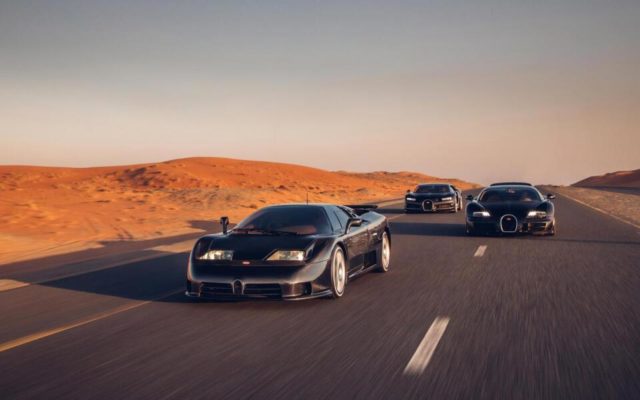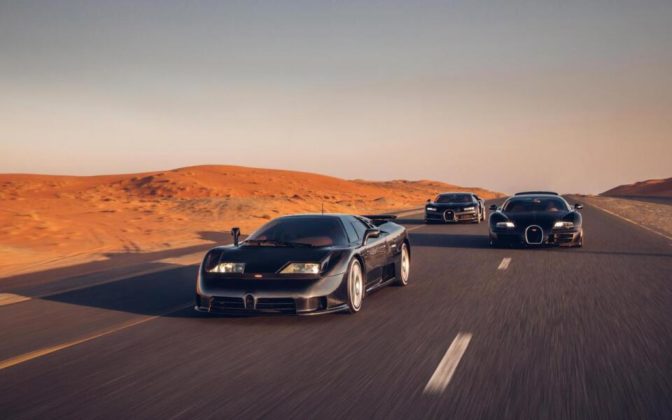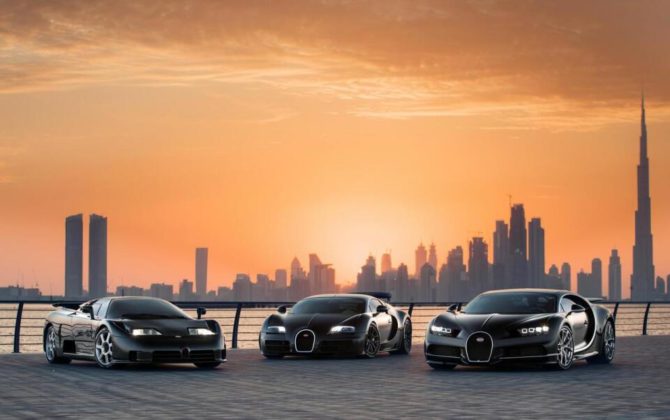From EB110 to Veyron to Chiron
Dubai – Bugatti has brought together three decades of performance domination in a Dubai photo shoot and desert dash that brought the latest Chiron together with its immediate predecessors, the Veyron and EB110.
The EB110 was first revealed back in 1991, and you’d be surprised at how many modern supercar ingredients are in place here.
Built around a lightweight monocoque that weighed just 125kg, the EB110 GT was the first series-produced car in the world to be made of carbon. The body used a combination of that and aluminium, while the wheels were cast from magnesium.
As with the Veyron and Chiron, four turbochargers were also part of the deal here, although the EB had a smaller 3.5-litre V12 engine. There was nothing small about the performance however. Capable of a 3.26-second 0-100km/h sprint, the EB110 was the fastest production car in its day, while the top speed of 351km/h also raised a few eyebrows.
The engine produced 412kW and revved all the way up to 8250rpm, while its quartet of blowers operated at boost pressures of between 1.05 and 1.2 bar to minimise turbo lag.
As if the GT simply wasn’t quick enough for some, Bugatti released a Super Sport variant in 1992, boasting more power (450kW) and a lower kerb weight.
But why did they call it the EB 110?
According to Bugatti, the car was named after Ettore Bugatti, and its Paris Motor Show reveal just happened to coincide with the company founder’s 110th birthday.
The EB110 is not exactly a common sight on the roads, with Bugatti having produced just 96 GT models and 40 Super Sports during its production run.
Bugatti Veyron
Arguably the most memorable Bugatti among modern hypercar fans is the Veyron 16.4 that was revealed back in 2005.
“The Veyron ushered in the new century and catapulted itself into a new dimension,” said Bugatti, and there’s no arguing with that logic when glancing over the ingredients.
With its 735kW, 1500Nm 8-litre W16 engine and 407km/h top speed, the Veyron was billed as the world’s first “true hyper sports car”. Featuring four turbos just like its forebear, the millennium Bugatti could accelerate from 0-100km/h in 2.5 seconds and reach the 200 mark in just 7.3.
Bugatti upped the ante again in 2010 with the Super Sport version that now boasted 882kW and a governed top speed of 415km/h. But Bugatti wasn’t just about throwing numbers around – in the same year it achieved a new speed record for road cars – the car managing 431km/h sans limiter.
While not a common vehicle by any stretch of the imagination, Bugatti did up the production volume, with a tally of 450 units, of which 48 were Super Sports. These low numbers have done wonders for resale values, with prices for Veyrons having increased by between 30 and 35 percent on average, according to Bugatti.
Bugatti Chiron
As the most modern Bugatti to date, revealed in 2016, the Chiron takes the power and performance game to the next level, its redesigned W16 producing an astounding 1103kW and 1600Nm, for a 0-100km/h time of under 2.5 seconds.
Although the top speed is limited to 420km/h, a modified version managed to hit the 490km/h mark in 2019.
To make it more agile than before, Bugatti threw in a five-mode adaptive chassis as well as an active aerodynamics system, lightweight carbon fibre monocoque structure and specially developed tyres. It is also said to have the best brakes in the world, which will probably seem quite handy once you’ve hit 490.
With this hypercar, Bugatti claims to have “tested the limits of physics” while achieving “significant improvements” in every conceivable area.
Bugatti is not upping the production run by much, with only 500 Chirons scheduled to hit streets around the world, and 250 have already been built.










